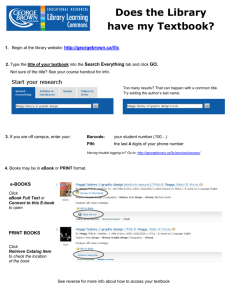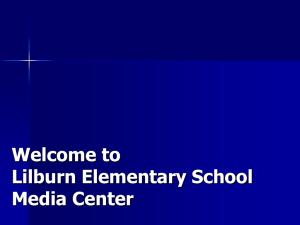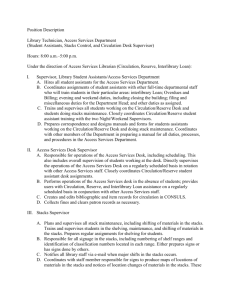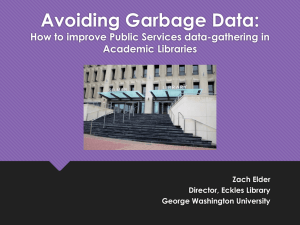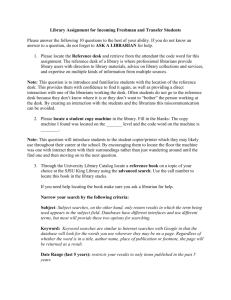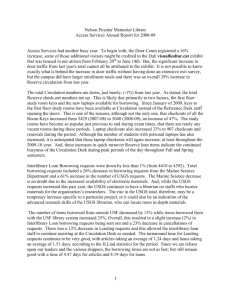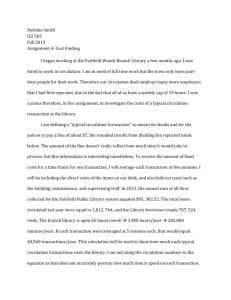Circulation and Access Services Discussion
advertisement
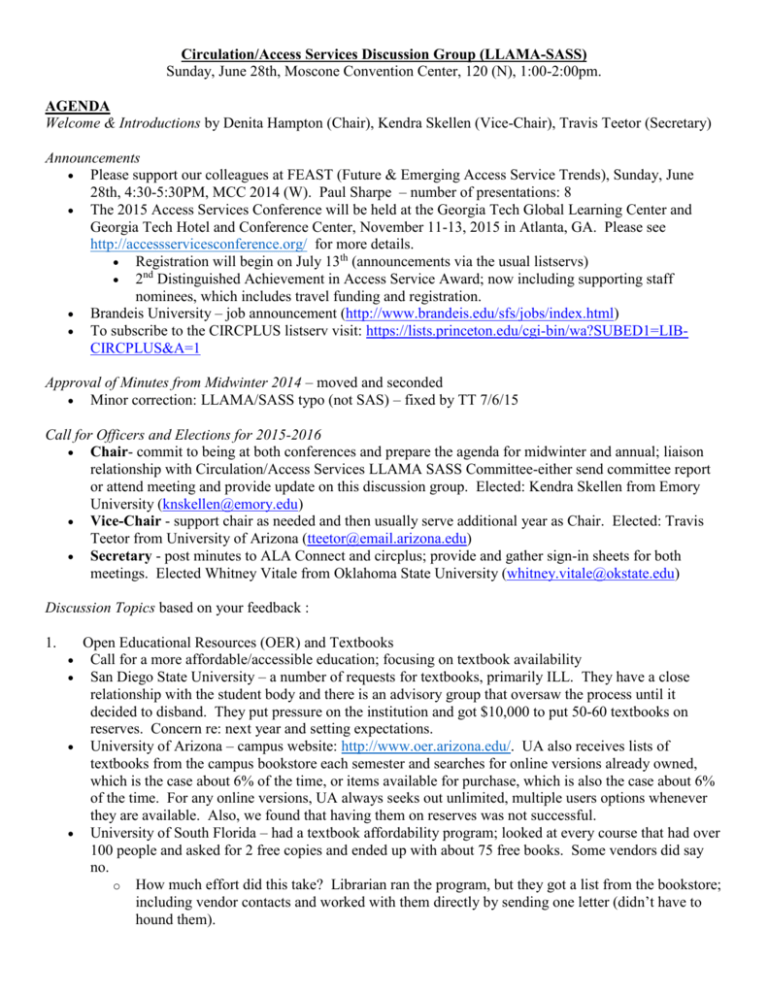
Circulation/Access Services Discussion Group (LLAMA-SASS) Sunday, June 28th, Moscone Convention Center, 120 (N), 1:00-2:00pm. AGENDA Welcome & Introductions by Denita Hampton (Chair), Kendra Skellen (Vice-Chair), Travis Teetor (Secretary) Announcements Please support our colleagues at FEAST (Future & Emerging Access Service Trends), Sunday, June 28th, 4:30-5:30PM, MCC 2014 (W). Paul Sharpe – number of presentations: 8 The 2015 Access Services Conference will be held at the Georgia Tech Global Learning Center and Georgia Tech Hotel and Conference Center, November 11-13, 2015 in Atlanta, GA. Please see http://accessservicesconference.org/ for more details. Registration will begin on July 13th (announcements via the usual listservs) 2nd Distinguished Achievement in Access Service Award; now including supporting staff nominees, which includes travel funding and registration. Brandeis University – job announcement (http://www.brandeis.edu/sfs/jobs/index.html) To subscribe to the CIRCPLUS listserv visit: https://lists.princeton.edu/cgi-bin/wa?SUBED1=LIBCIRCPLUS&A=1 Approval of Minutes from Midwinter 2014 – moved and seconded Minor correction: LLAMA/SASS typo (not SAS) – fixed by TT 7/6/15 Call for Officers and Elections for 2015-2016 Chair- commit to being at both conferences and prepare the agenda for midwinter and annual; liaison relationship with Circulation/Access Services LLAMA SASS Committee-either send committee report or attend meeting and provide update on this discussion group. Elected: Kendra Skellen from Emory University (knskellen@emory.edu) Vice-Chair - support chair as needed and then usually serve additional year as Chair. Elected: Travis Teetor from University of Arizona (tteetor@email.arizona.edu) Secretary - post minutes to ALA Connect and circplus; provide and gather sign-in sheets for both meetings. Elected Whitney Vitale from Oklahoma State University (whitney.vitale@okstate.edu) Discussion Topics based on your feedback : 1. Open Educational Resources (OER) and Textbooks Call for a more affordable/accessible education; focusing on textbook availability San Diego State University – a number of requests for textbooks, primarily ILL. They have a close relationship with the student body and there is an advisory group that oversaw the process until it decided to disband. They put pressure on the institution and got $10,000 to put 50-60 textbooks on reserves. Concern re: next year and setting expectations. University of Arizona – campus website: http://www.oer.arizona.edu/. UA also receives lists of textbooks from the campus bookstore each semester and searches for online versions already owned, which is the case about 6% of the time, or items available for purchase, which is also the case about 6% of the time. For any online versions, UA always seeks out unlimited, multiple users options whenever they are available. Also, we found that having them on reserves was not successful. University of South Florida – had a textbook affordability program; looked at every course that had over 100 people and asked for 2 free copies and ended up with about 75 free books. Some vendors did say no. o How much effort did this take? Librarian ran the program, but they got a list from the bookstore; including vendor contacts and worked with them directly by sending one letter (didn’t have to hound them). 2. 3. Loyola University New Orleans – met with faculty from each department and talked about open textbooks and encouraged their use. They also asked faculty to put textbooks on reserve. They used fines and fees to purchase textbooks and reported out use to faculty each semester. Benefits of Combining Reference and Circulation Desk to One Point Information Services Desk Presentation at ALA this morning – look for the presentation to be posted for more details Enoch Pratt at Baltimore Maryland – resistance to implementing and would like to hear more. Some of the circulation managers at their libraries don’t know how to type - skill sets and salary difference are a bit part of the argument. Also, in academics, circulation supervisors are the brunt of running the institution and are most of the in-person interactions. University of Cincinnati – 1 year ago combined circulation and access services. They had a lot of data (reference numbers were going way down and they were not very complex) and discussion about merging these desk, in part because they were in very close proximity. In the end, they pulled librarians off the desk. Initially, there was resistance from support staff, but they were involved in the conversation to understand reasons behind resistance. They were also given a lot of training and were paired with students who provided support for circulation and reference. They are currently redesigning their desks to achieve better integration. Definitely work towards getting as much input from staff as possible. Emory University – worked with both a public and academic library that combined. She looked at job descriptions and created a more cohesive unit; including looking at pay equity issues (this is key). All of their staff had BAs. They initially had librarians on the desk for a couple hours a week, but are phasing them out. On the public side, they phased out the circulation staff instead of reference. They are also combining with Learning Commons and technology (answering 2,000 questions per semester compared to the ~300 answered by the desk dedicated to this work). Loyola University New Orleans - They were sitting at the reference desk with nothing to do, but the circulation desk was busy. They now mostly have a librarian with 2 students. When questioned about why spend librarians salary to circulate, it is really about making connections with each person. Some questions are more complex than they seem on the surface and can lead to purchase decisions. Pennsylvania – renovation that lead to just having a circulation desk and no reference desk. Librarians are available and can work from wherever they are needed. They make referrals as needed. UC San Diego – Responsible for building management; including safety and security where they have a strong relationship with the security staff. In this role, you need to have a hand in facilities issues. It is important to have an updated job description that reflects all of these tasks. DePaul University – they don’t have a combined desk, but any reference questions they answer get counted for reference stats. Paul Sharpe (Journal of Access Services editor) – poll on whether there should be a special issue on merged desks: overall, there was consensus on doing this. 3D Scanning. Advice on models, software, and staffing. University of Arizona – implemented 3D printing and looking to augment. Have heard from a lot other others that they are using NextEngine and they seem to like it, but would like to know how user friendly it is. Also, just want to get a sense of how many libraries are heading in this direction. Cal Tech – (3) 3D printers and some scanners, starting this fall. Students will lead the process and they will probably allow people to use it for free the first year. Virginia Commonwealth – Thomas Lipinski spoke during the conference and said that libraries can avoid liability by not printing anything and instead putting printing in the hands of the patron. There was also a good makerspace session yesterday afternoon. 4. Scope of Services that other Access Services programs/departments provide, especially in terms of physical access to library materials. UC San Diego – working relationship with facilities and those with collection development, but do they follow standards for stacks fill rates (using 75% figure). When should they let librarians know that they need to do weeding? Miami University – believes that the 75% standard does exist (ACRL). They measured and found their stacks were at 80% and have a zero growth policy. They provide reports to selectors twice per year. Harvard University – anyone who walks through the stacks should take pictures and report it to those responsible for stacks management. Bridgeport Public (and previously Yale) – in charge of stacks and gets out of her seat and looks at the amount of room on the shelf. If you bring in five, then five need to leave. Millersville University of Pennsylvania – During renovation: planned for 85% full shelves, but eBooks have reduced the amount being purchased each year and they are doing regular weeding. The fewer items that you need to move, the less it will cost you (they weeded about 100,000 items and are down to about 150,000 items total). You can also rely on ILL staff and students to bring forward massive shifts and need for shelf reading. They are not on an approval plan and electronic content is 98% of their purchasing. They also reclassed all of their Dewey and had to integrate with LC, which required a lot of attention because of having to swing the collection out and integrate in chunks. Stanford – large weeding project because they are currently at 98% capacity and are bringing in a lot of new collections; including a large map collection. Their AUL is using a lot of analytics to make decisions. Since they are closed stacks, they can use data on who is using the physical space – they found that computer science and engineers were their largest users. They are also pulling items out to remote storage since people aren’t using materials as much.
